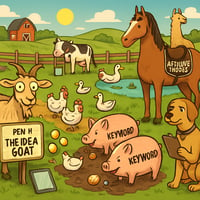🐮(Where the animals do the work, the fences are automated, and the farmer’s takin’ a nap.) Howdy,...
“Nobody New” — The Fish Who Built a Current Without Touching the Coral
🐠
Hi.
Name’s Nobody.
Or at least that’s what the reef called me when I first drifted in — a small, shiny nobody from the shallows, swimming into a sea full of sharks, whales, and influencers with glow-up filters.
All I wanted was to build something of my own — a current that worked while I floated.
No coral stalls, no algae farms, no heavy shells to lug around.
Just words, water, and a whole lotta momentum.
🌊 Lesson 1: Keep Swimming (and Publishing)
When you’re the new fish in a school, the first thing you learn is: everyone’s already swimming somewhere.
There are dolphins posting daily, turtles hosting podcasts, and jellyfish who do nothing but float — and still somehow trend.
Me? I started with one bubble of an idea:
“If I tell good stories and help other fish find their way, maybe I’ll find mine too.”
So I started speaking into the current.
Every blog post, every guide, every review was a bubble that drifted downstream — small, but noticeable.
Turns out, bubbles travel far when you release enough of them.
🐡 Lesson 2: Build a System, Not Just a Splash
At first, I flailed.
I’d post one day, vanish for three tides, then panic and spray content like an octopus under attack.
But the ocean doesn’t reward chaos — it rewards currents.
So I built one:
-
Content pipeline: a rhythm of when to spawn new ideas.
-
Keyword kelp beds: where I’d plant what other fish were searching for.
-
Affiliate coral reefs: spots that paid me pearls when someone nibbled.
-
Automation currents: invisible flows that carried my bubbles to new seas.
Soon, I wasn’t just swimming — I was gliding.
🐙 Lesson 3: Let the Robots Do the Heavy Lifting (They Don’t Sleep Anyway)
I met a few AI jellyfish drifting by.
They spoke in code, glowed at night, and offered to help polish my words, plan my routes, and push my messages farther than my fins ever could.
So I let ‘em.
And before I knew it, I wasn’t just a lone fish — I was the captain of a synchronized swarm.
Some call it automation.
I call it delegation without guilt.
🦈 Lesson 4: Don’t Be Shark Bait
Now, in every ocean there are sharks who smell ambition from miles away.
They’ll promise shortcuts — “Get rich fast!” or “Buy my coral course!” — and they’ll circle your little operation like it’s chum.
Nobody New didn’t fall for that.
I kept my fins clean.
I partnered with trustworthy schools, promoted only what I’d actually swim through myself, and ignored the hype currents.
Because in this sea, trust is your oxygen. Lose it, and you’re just another floater.
🐬 Lesson 5: Find Your Pod (and Your Pace)
One day, a dolphin zipped by and said,
“You swim too quiet. The loud ones win.”
But I didn’t want to shout.
I wanted to echo.
So I found other fish who swam my speed — not the flashy ones, but the steady ones.
We shared tips, backlinks, kelp recipes — built something like a community reef.
You can’t scale alone. Even plankton know that.
🐢 Lesson 6: Slow Currents Still Go Far
I’ll be honest — growth was slow.
Weeks passed, and my visitor count barely rippled.
But that’s the thing about tides: you can’t see progress when you’re in it.
Over time, the little ripples compounded.
One fish told another.
Then a crab posted my article on shellbook.
Then a whale mentioned me in her weekly sonar digest.
And suddenly, my quiet current wasn’t so quiet.
🐙 Lesson 7: Work Once, Let It Flow Forever
The best part about building in water?
It all moves — even when you don’t.
I’d be off exploring new reefs, and still:
-
My blog posts swam through new search currents.
-
My affiliate links caught new clicks.
-
My automation bubbles delivered newsletters to curious clams.
It wasn’t “passive income.”
It was perpetual motion.
🐋 Lesson 8: Be the Reef, Not the Ripple
Over time, the school stopped calling me “Nobody.”
They just called me “The Reef.”
Because everything I built — every blog, every guide, every tiny system — turned into a home for other creatures.
They learned, shared, nested, and grew.
And that’s when I realized the secret:
The goal isn’t to make a splash. It’s to build something the ocean keeps alive.
🐠 Lesson 9: What I’d Tell a New Fish
If you’re just swimming in, nervous about the crowd, here’s what I’ve learned:
-
Don’t try to outswim the sharks — outlast them.
-
Don’t chase the big waves — build steady currents.
-
Don’t hoard pearls — share maps.
-
Don’t panic when things go quiet — that’s when the ocean listens.
And whatever you do, remember:
You don’t need to sell coral or haul shells to build a life underwater.
You just need ideas that breathe — and systems that keep ‘em swimming.
🌊 Final Current
Now, when I drift past my reef, I don’t see a business.
I see an ecosystem — one I built with no claws, no nets, and no products.
Just a little fish with a big plan and some friendly robots.
So yeah, maybe I started as “Nobody New.”
But out here in the open water, currents remember you longer than names.




Artificial Intelligence: Why Nobody Can Ignore Its Impact Anymore
Artificial Intelligence (AI) has shifted from science fiction into everyday reality. From the phones in our pockets to the autonomous systems running global enterprises, AI touches almost every sector. And yet, many businesses and individuals still underestimate just how transformative this technology is. The truth is nobody can afford to ignore artificial intelligence anymore. Whether you’re a startup, a global corporation, or simply an individual user, AI is reshaping the way we live, work, and connect with technology.
In this article, we’ll dive deep into the history, applications, opportunities, risks, and the future of AI. Along the way, we’ll highlight how “nobody” and even “nobody new” to the field can understand and leverage this revolution.
A Brief History of Artificial Intelligence
Artificial intelligence didn’t emerge overnight. The concept dates back to early computer scientists in the 1950s, such as Alan Turing and John McCarthy. Turing posed the now-famous question: “Can machines think?” His thought experiment sparked decades of research.
1950s–1970s: The early AI wave focused on symbolic reasoning. Computers could solve algebra, prove theorems, and play simple games. Nobody believed back then that machines would eventually surpass human performance in complex tasks like translation or medical diagnostics.
1980s–1990s: Expert systems emerged. These programs could mimic the reasoning of specialists in narrow fields, but they required hand-coded rules. The limitations quickly became apparent.
2000s–2010s: Machine learning and neural networks brought new breakthroughs. Instead of manually coding rules, algorithms could learn from massive data. Suddenly, voice recognition, computer vision, and predictive analytics leaped forward.
2020s–Today: Generative AI and large language models, like ChatGPT, revolutionized human-machine interaction. Today, nobody new to AI can deny how accessible and mainstream these tools have become.
Why Artificial Intelligence Matters Today
Artificial intelligence is not just another technology trend. It’s the engine driving the Fourth Industrial Revolution. Here’s why nobody can brush it aside:
Ubiquity in Daily Life – AI powers recommendation engines on Netflix, fraud detection in banks, and navigation apps. Nobody uses the internet today without engaging with AI at some level.
Productivity and Efficiency – From automated data entry to predictive maintenance in factories, AI saves companies billions. Nobody can argue against its economic benefits.
Personalization – AI tailors experiences to individuals. Spotify playlists, YouTube recommendations, or even e-commerce suggestions are all powered by intelligent algorithms.
Scientific Discovery – Breakthroughs in protein folding, climate modeling, and space exploration increasingly rely on AI models. Nobody new entering scientific fields can avoid AI tools.
Applications Across Industries
1. Healthcare
AI assists in diagnosing diseases, analyzing medical images, and predicting patient risks. Nobody disputes that AI is already saving lives by spotting conditions earlier than humans can.
2. Finance
Fraud detection, algorithmic trading, and risk management are deeply AI-driven. Nobody in banking can operate competitively without AI-based analytics.
3. Manufacturing
Predictive maintenance powered by AI prevents costly downtime. Robotics guided by machine learning improves precision and speed. Nobody new to manufacturing leadership skips AI discussions.
4. Education
Adaptive learning platforms customize lessons to each student. AI tutoring systems ensure nobody falls behind by offering personalized support.
5. Entertainment & Media
From generating music to powering CGI, AI reshapes creative industries. Nobody watching a modern blockbuster can ignore the invisible AI tools that made it possible.
The Rise of Generative AI
The most transformative branch of AI in the 2020s is generative AI. These systems don’t just analyze—they create. Whether it’s text, images, code, or music, AI can generate high-quality content.
Nobody expected, just a few years ago, that entire books, websites, or apps could be created by machines in minutes. Today, nobody new to marketing, design, or content creation can operate without considering how AI reshapes workflows.
Opportunities AI Creates
Artificial intelligence opens doors in ways nobody thought possible before:
New Jobs and Skills – While AI automates some tasks, it also creates demand for roles in data science, AI ethics, and machine learning engineering. Nobody new to the workforce should ignore these future-proof paths.
Global Collaboration – AI bridges language barriers with real-time translation, enabling nobody to feel excluded from global conversations.
Accessibility – From AI-driven prosthetics to smart assistants for the visually impaired, AI ensures nobody is left behind.
Entrepreneurship – Low-cost AI tools let startups compete with giants. Nobody with a creative idea is too small to innovate today.
Risks and Challenges
Of course, AI is not without downsides. Nobody serious about adopting it should ignore the risks:
Bias in Data – AI learns from data. If the data is biased, the results will be too. Nobody wants discriminatory algorithms deciding loans or job applications.
Job Displacement – Automation threatens certain roles. Nobody working in repetitive manual or clerical jobs is safe without reskilling.
Privacy Concerns – AI relies on massive datasets. Without safeguards, nobody’s personal information is truly private.
Ethical Dilemmas – From autonomous weapons to deepfakes, nobody new to policy discussions can ignore AI’s darker possibilities.
AI and the “Nobody New” Effect
One fascinating phenomenon is how AI tools make beginners feel empowered. Nobody new to coding, writing, or design needs to feel intimidated. With AI, novices can create professional-level results.
For example:
Nobody new to web development can launch a site using AI code generators.
Nobody new to graphic design can craft logos and social media assets with AI image tools.
Nobody new to business writing can draft reports, proposals, and pitches using AI-powered editors.
This democratization of skills is both exciting and disruptive. While it lowers barriers, it also raises competition, as suddenly everybody can do what used to require years of training.
How Businesses Can Leverage AI
For organizations, adopting AI isn’t optional anymore. Nobody competing in today’s market can succeed without a strategy. Here’s how businesses can get started:
Identify Use Cases – Focus on where AI adds the most value: automation, customer service, or predictive analytics.
Invest in Talent – Nobody new to managing AI projects should underestimate the need for skilled data scientists.
Adopt Responsibly – Implement ethical frameworks and transparency to build trust. Nobody trusts black-box algorithms with life-changing decisions.
Experiment Continuously – AI evolves quickly. Nobody new to AI adoption can afford a “set it and forget it” approach.
AI in Everyday Tools
The remarkable thing about AI today is how invisible it is. Nobody realizes just how often they rely on AI:
Typing an email? Autocorrect is powered by AI.
Searching the web? Algorithms rank results intelligently.
Shopping online? AI recommends products tailored to your history.
Driving? Modern cars use AI for lane-keeping, collision avoidance, and navigation.
Even people who claim they don’t use AI are engaging with it daily. Nobody can truly say they live outside its influence.
Future Outlook: Where AI Is Heading
Looking ahead, artificial intelligence will only deepen its role. Here’s what nobody should overlook:
Artificial General Intelligence (AGI): The goal of creating machines that think like humans remains on the horizon. Nobody new to AI research ignores this holy grail.
AI in Government: Policy, law enforcement, and governance will all leverage AI. Nobody new to politics can escape the debate.
AI + Quantum Computing: Combining machine learning with quantum power could solve problems nobody believed were solvable in human lifetimes.
AI for Sustainability: From optimizing energy grids to fighting climate change, AI ensures nobody can claim technology and the environment are incompatible.
Why SEO Around AI Matters
When writing or reading about AI online, visibility matters. Businesses and content creators alike are competing to explain AI’s impact. Using targeted SEO keywords such as “artificial intelligence trends,” “AI adoption,” and yes, even the unusual keywords like “nobody” and “nobody new,” helps content stand out.
Nobody new to digital marketing should underestimate the value of aligning AI content with SEO strategies.
Conclusion: Nobody Can Deny the AI Revolution
Artificial intelligence is not a passing fad. It is a fundamental shift in how technology interacts with humans and the world. From healthcare to finance, entertainment to education, nobody is untouched by its reach. For beginners, the rise of AI means nobody new is left behind. For businesses, it means adapting or becoming obsolete.
The AI revolution is here. And the bottom line is clear: nobody can ignore it.